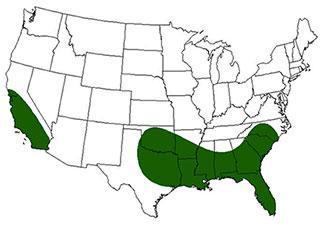I am trying to shift my grass mowing schedule off, by a couple of days, so it will look nice for a specific date. As I was glancing over it, I realized I don't really have a "normal" grass. Most people have heard of Zoysia, Centipede or Bermuda. I mostly have Bahia.
Bahiagrass (Paspalum notatum) was introduced from Brazil in 1914. It was originally used as a pasture grass on the sandy soils of the Southeastern United States. It is also known as Highway Grass.It is an aggressive, warm season perennial (comes back every year) grass. Bahiagrass is primarily planted in the deep South and coastal areas as shown in this map.

Bahiagrass spreads by seeds and rhizomes (a horizontal, modified stem found at or just below ground level) and forms an extensive, deep root system. It sustains better than other grasses in infertile, sandy soils and does not require high inputs of water or fertilizer. It is very drought tolerant. The aggressive nature and drought tolerance of Bahiagrass makes it ideal for erosion control along roadsides and highway rights of way. Hence it's other name of Highway Grass. This does come at a cost though, it also makes it difficult to control as a weed in the landscape. Or in my case, the entire lawn. Although Bahiagrass does not produce a carpet like, dense lawn like some other warm season lawn grasses, it does provide a good, low maintenance lawn where slightly reduced visual quality is acceptable. That is me all over!
Bahiagrass is easily identified by its distinctive “Y-shaped” seed head. You have probably seen it a million times if you have spent anytime in the South. It looks like this:

There are some disadvantages to having this grass take over the yard. Many people find the tall, unsightly seed heads that show up throughout the Summer, and Fall months objectionable. So to this end, it needs to be cut every 5-7 days. Those seed stems are also very tough and can wear out mower blades, requiring them to be sharpened frequently. It is recommended that it be cut to a height of 3-4 inches.
Bahiagrass will go dormant and turn brown during drought situations and in the Winter after the first good frost. It also responds quickly to rainfall after a severe drought, greening up fast.
It prefers an acidic soil,or low pH. A high pH tends to cause yellowing of the leaf tissue due to its inability to absorb iron, causing an iron deficiency. In the research I have seen, this grass does not have good tolerance for shade, traffic, or saltwater. I can agree with the shade and traffic, it definitely does not like to grow under trees or be stepped upon a lot. I do not have any salt issues, so I can only go by the research here, but it would not surprise me to see it flounder at the beach. Some pun intended.
Bahiagrass has very few to any insect problems, but it is susceptible to mole crickets. There are only a few disease problems, none of which are severe, and for the most part are rare.
Many people out there that want a golf course perfect looking lawn. Bahiagrass will screw that up in a heartbeat. It grows in an open growth habit, which can result in weed encroachment into sparse areas. It has a coarse leaf texture and it provides less cushioning for recreational activities than some of the other grass' might. I am not going to go into the ins and outs of ridding your grass of this weed. There are many products out there, all with different ways and times of application, for control. Before starting a weed control program homeowners should realize that complete eradication of Bahiagrass (or any weed for that matter) from the landscape is not practical. A better approach is to control (not eradicate) the weed by limiting the infestation to a tolerable level.
The way I look at it, if it is green and it is growing, I have a lawn!
Happy Growing!
Darren

